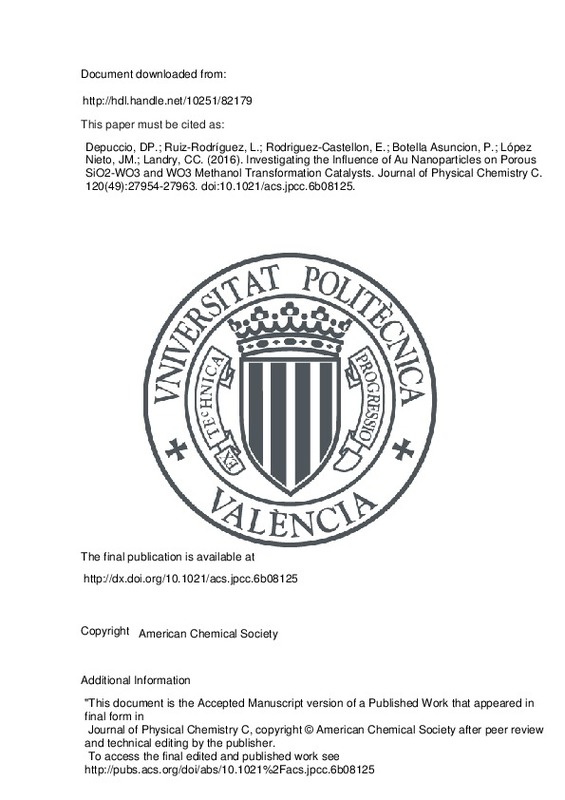JavaScript is disabled for your browser. Some features of this site may not work without it.
Buscar en RiuNet
Listar
Mi cuenta
Estadísticas
Ayuda RiuNet
Admin. UPV
Investigating the Influence of Au Nanoparticles on Porous SiO2-WO3 and WO3 Methanol Transformation Catalysts
Mostrar el registro sencillo del ítem
Ficheros en el ítem
| dc.contributor.author | DePuccio, Daniel P.
|
es_ES |
| dc.contributor.author | Ruiz-Rodríguez, Lidia
|
es_ES |
| dc.contributor.author | Rodriguez-Castellon, Enrique
|
es_ES |
| dc.contributor.author | Botella Asuncion, Pablo
|
es_ES |
| dc.contributor.author | López Nieto, José Manuel
|
es_ES |
| dc.contributor.author | Landry, Christopher C.
|
es_ES |
| dc.date.accessioned | 2017-06-01T10:55:59Z | |
| dc.date.issued | 2016-12-15 | |
| dc.identifier.issn | 1932-7447 | |
| dc.identifier.uri | http://hdl.handle.net/10251/82179 | |
| dc.description | "This document is the Accepted Manuscript version of a Published Work that appeared in final form in Journal of Physical Chemistry C, copyright © American Chemical Society after peer review and technical editing by the publisher. To access the final edited and published work see http://pubs.acs.org/doi/abs/10.1021%2Facs.jpcc.6b08125 | es_ES |
| dc.description.abstract | Analyzing the structural and chemical properties of materials at the interface of metal nanoparticles and metal oxide supports is important for catalytic applications. Tungsten oxide (WO3) is a widely studied catalyst, but changing the catalytic reactivity at the surface of this oxide with metal nanoparticles is of interest. In this work, we sought to modify the redox properties of porous WO3 and SiO2 WO3 catalysts with sonochemically deposited gold nanoparticles (Au NPs) in order to access and study this reaction pathway. Characterization using powder X-ray diffraction (XRD), high-resolution transmission electron microscopy (HR-TEM), X-ray photoelectron spectroscopy (XPS), and inductively coupled plasma optical emission spectroscopy (ICP-OES) confirmed that crystalline Au NPs with diameters of 5-12 nm were distributed throughout the catalysts. Temperature-programmed desorption (TPD) was used to probe the surface acidity of the catalysts. The physico-chemical characteristics of catalysts have been also discussed by considering the catalytic performance of these materials in the aerobic transformation of methanol. Catalysts containing nanocrystalline WO3 but no Au NPs displayed very high selectivity to DME (>60%) at all conversions with minor oxidation reactivity, which highlighted the acidic nature of these catalysts. No effect on the acidity of the catalysts was observed by TPD when Au NPs were loaded in the catalysts. The reducibility of the crystalline WO3 species, however, increased significantly due to the interaction with Au NPs, as observed by temperature-programmed reduction (TPR). In the gas-phase transformation of MeOH under aerobic conditions, catalysts modified with Au NPs showed greater activity compared to nonmodified catalysts. In addition, oxidation selectivity to products such as methyl formate as well as formaldehyde, dimethoxymethane, and carbon oxides became heavily favored with only minor dehydration selectivity. The redox properties of these WO3 catalysts could be tuned by changing the Au loading. More labile lattice oxygen and enhanced redox properties at the surface of WO3 modified with Au NPs clearly altered these traditional dehydration catalysts to potential oxidation catalysts. Thus, modification of WO3 with Au is an effective way to expand the MeOH transformation product distribution beyond DME to other useful, oxidized products not typically observed over pure WO3. | es_ES |
| dc.description.sponsorship | The authors would like to thank the University of Vermont and the DGICYT in Spain (CTQ2015-68951-C3-1-R, CTQ2012-37925-C3-3-R, and SEV-2012-0267 Severo Ochoa Projects) for financial support and David M. Parker for assistance with catalyst synthesis. | en_EN |
| dc.language | Inglés | es_ES |
| dc.publisher | American Chemical Society | es_ES |
| dc.relation.ispartof | Journal of Physical Chemistry C | es_ES |
| dc.rights | Reserva de todos los derechos | es_ES |
| dc.subject | Au Nanoparticles catalyst | es_ES |
| dc.subject | Porous SiO2-WO3 and WO3 support | es_ES |
| dc.subject | Methanol aerobic Transformation | es_ES |
| dc.title | Investigating the Influence of Au Nanoparticles on Porous SiO2-WO3 and WO3 Methanol Transformation Catalysts | es_ES |
| dc.type | Artículo | es_ES |
| dc.embargo.lift | 10000-01-01 | |
| dc.embargo.terms | forever | es_ES |
| dc.identifier.doi | 10.1021/acs.jpcc.6b08125 | |
| dc.relation.projectID | info:eu-repo/grantAgreement/MINECO//CTQ2015-68951-C3-1-R/ES/TRATAMIENTOS CATALITICOS AVANZADOS PARA LA VALORIZACION DE LA BIOMASA Y LA ELIMINACION DE RESIDUOS ASOCIADOS/ | es_ES |
| dc.relation.projectID | info:eu-repo/grantAgreement/MINECO//CTQ2012-37925-C03-03/ES/Catalizadores para la energía y el medio ambiente: hidrodesulfuración e hidrodeoxigenación/ | es_ES |
| dc.relation.projectID | info:eu-repo/grantAgreement/MINECO//SEV-2012-0267/ | es_ES |
| dc.rights.accessRights | Abierto | es_ES |
| dc.contributor.affiliation | Universitat Politècnica de València. Instituto Universitario Mixto de Tecnología Química - Institut Universitari Mixt de Tecnologia Química | es_ES |
| dc.description.bibliographicCitation | Depuccio, DP.; Ruiz-Rodríguez, L.; Rodriguez-Castellon, E.; Botella Asuncion, P.; López Nieto, JM.; Landry, CC. (2016). Investigating the Influence of Au Nanoparticles on Porous SiO2-WO3 and WO3 Methanol Transformation Catalysts. Journal of Physical Chemistry C. 120(49):27954-27963. https://doi.org/10.1021/acs.jpcc.6b08125 | es_ES |
| dc.description.accrualMethod | S | es_ES |
| dc.relation.publisherversion | http://dx.doi.org/10.1021/acs.jpcc.6b08125 | es_ES |
| dc.description.upvformatpinicio | 27954 | es_ES |
| dc.description.upvformatpfin | 27963 | es_ES |
| dc.type.version | info:eu-repo/semantics/publishedVersion | es_ES |
| dc.description.volume | 120 | es_ES |
| dc.description.issue | 49 | es_ES |
| dc.relation.senia | 332647 | es_ES |
| dc.contributor.funder | Ministerio de Economía y Competitividad | es_ES |
| dc.contributor.funder | University of Vermont | es_ES |







![[Cerrado]](/themes/UPV/images/candado.png)

